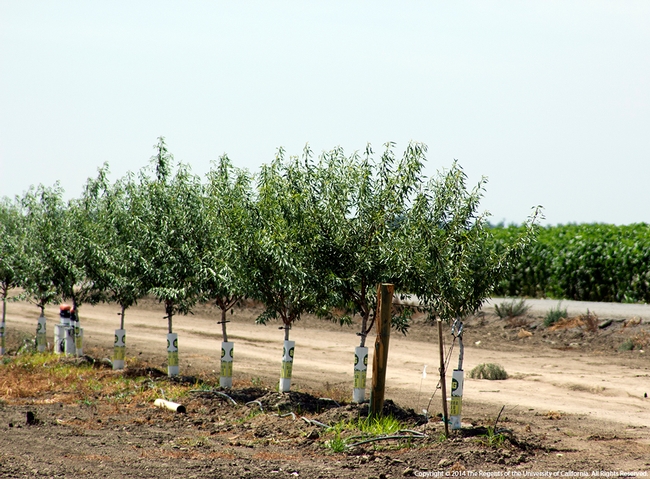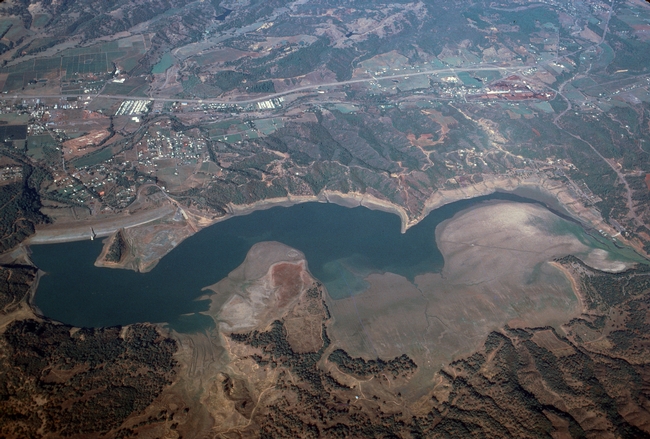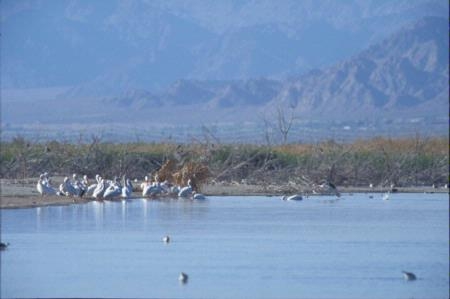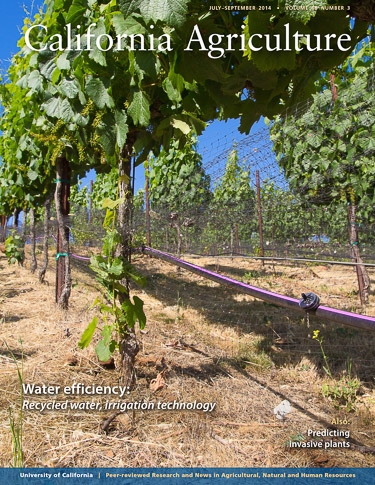
Posts Tagged: Quantity
Impact of Controlling Yellow Starthistle on Watershed Runoff and Groundwater Levels
Yellow starthistle (Centaurea solstitialis) (YST) is the most pervasive invasive and noxious weed in California. Previous work showed that YST uses substantially more water than forage annual grasses it typically displaces. Soil moisture was 20% higher in annual grass test sites compared to YST...
What can California, Israel and Australia learn from each other about drought?

Drought management experts from Israel and Australia will join U.S. scientists in California for a workshop in Modesto on Jan. 12 and 13. Growers, crop consultants, irrigation practitioners, state agency members and others are invited to participate.
The two-day event, “Proven Solutions to Drought Stress: Water Management Strategies for Perennial Crops with Limited and Impaired Water Supplies,” is designed to foster conversation on a variety of drought management aspects and strategies. The drought workshop will be held at the Modesto Centre Plaza at 1150 9th Street in Modesto.
“California, Israel and Australia have all faced recurring drought conditions of varying severity and duration,” said James Ayars, research agricultural engineer of USDA Agricultural Research Service in Parlier, Calif., who spearheaded the event to bring together this prestigious group of scientists. “In view of more frequent and more severe recurring droughts in the years to come, it makes sense for us to pool our knowledge and plan more strategically for the future.”

Other speakers include Shabtai Cohn, head of Israel's Agricultural Research Organization Soil, Water and Environmental Sciences Institute, John Hornbuckle, associate professor at Deakin University in Australia, and other researchers from Israel and Australia.
This workshop is sponsored by the USDA Agricultural Research Service, UC Agriculture and Natural Resources (UC ANR), UC California Institute for Water Resources and the Israel Ministry of Agriculture's Agricultural Research Organization.
“We hope to share expertise gained from experiences in our respective countries and learn new approaches for growing crops with limited water and poor quality water under the prospect of increased climate variability and change,” said Daniele Zaccaria, UC ANR Cooperative Extension specialist in agricultural water management in the Department of Land, Air and Water Resources at UC Davis and one of the event organizers. “Although Australia and Israel have very different climatic and socioeconomic conditions, there may be drought management strategies and policies that work in California that they can apply, and they may have practices and policies that we can adapt to address issues in California.”

Registration is $80 and includes lunch for both days. Dec. 18 is the deadline for early registration. After Dec. 18, registration is $120 until Jan. 1, 2016, and $150 after Jan. 1. There will be no on-site registration.
Certified crop advisers can earn continuing education units: Soil & Water Management 12.0 CEU and Crop Management 0.5 CEU.
To see the agenda and to register, please visit http://www.droughtmgt.com.
Lodging is available next to the Modesto Centre Plaza at the DoubleTree Hotel at 1150 9th Street in Modesto.
From fracking to water affordability, UC takes on new water-related research

High-volume hydraulic fracturing, or fracking, a form of natural gas and oil extraction, is water-intensive and could exacerbate water stress. Gwen Arnold, professor in the Department of Environmental Science and Policy at UC Davis, is examining efforts to locally restrict high-volume hydraulic fracturing.
“There's a lot of concern over water pollution and water use in communities,” said Doug Parker, UC ANR California Institute for Water Resources director. “We're looking at the characteristics of communities that have voted on measures to restrict the practice of fracking, both where the measures have failed and where they've passed.”
Parker expects that people on either side of the issue will be able to use the study's finding to better understand differing viewpoints. Decision-makers who may be contemplating policy action on fracking will also benefit from seeing the range of relevant policies passed by other jurisdictions and the conditions that appear to favor or discourage adoption of the policies.
Another research project is assessing the Integrated Regional Water Management approach to address the lack of safe and affordable water in disadvantaged communities throughout the state. In 2011, the California Department of Water Resources funded seven pilot projects to develop models for improving water supplies for these communities.
“We want to take a look at how well Integrated Regional Water Management worked, whether it is meeting the needs of providing safe, affordable drinking water,” Parker said.
Jonathan London, professor in the Department of Human Ecology and director of the Center for Regional Change at UC Davis, and Carolina Balazs, UC presidential postdoctoral research fellow at UC Davis, are evaluating the impact of those efforts in Inyo-Mono counties, Santa Cruz, Los Angeles County, Kings Basin, North Coast, Imperial Valley and Coachella Valley.

- Roya Bahreini, professor in the Department of Environmental Sciences at UC Riverside, is looking at the relationship between water management and air quality in the Salton Sea region of southern California, where low water levels are leading to increased dust from the dry lakebed.
- Igor Lacan, UC ANR Cooperative Extension advisor in San Mateo-San Francisco counties, is investigating the performance of trees used in streetside stormwater management facilities, which are increasingly common in cities across California as communities look for ways to increase groundwater infiltration.
- Bruce Linquist, UC ANR Cooperative Extension specialist in the Department of Plant Sciences UC Davis, is quantifying methylmercury loads from rice fields to determine whether they may be of concern.
- Clarissa Nobile, professor in the School of Natural Sciences at UC Merced is using a high-tech metagenomic approach to research a potential problem for groundwater wells across the state: biofouling, which has the potential to be a costly challenge.
Learn more about these and other California Institute for Water Resources research projects by visiting http://ciwr.ucanr.edu/CIWR_Making_a_difference.
The California Institute for Water Resources integrates California's research, extension, and education programs to develop research-based solutions to the state's water resource challenges. An initiative to maintain and enhance healthy families and communities is part of the UC Agriculture and Natural Resources Strategic Vision 2025.
California Ranch Stewardship Workshop - Oct 21, 2014, 1-4 pm Ukiah, CA
Great News!
Ken Tate has agreed to expand his presentation at the upcoming California Ranch Stewardship Workshop on October 21 from 1- 4 pm at the Farm Advisors' office! His presentation is entitled Research Update: Grazing and
Environmental Topics. This is a very timely subject as Ken will be highlighting new research that has focused on water quality, sensitive species conservation and riparian health – important to both Mendocino and Lake County ranchers as they deal with on-going regulations. Ken will provide the science that landowners need to be informed when dealing with regulatory agencies. You don't want to miss it!
Remember. Preregistration ($15) is required either by credit card, check or cash at our web site at: http://ucanr.edu/survey/survey.cfm?surveynumber=13795 to ensure we have sufficient handouts and refreshments (We've had numerous requests for Schat's cookies.). If you'd like to pay by check or cash contact our office and talk to either JT or Tanis. (707) 463-4495.
Hope to see you there!
CA Ranch Stewardship Workshop
California Agriculture focuses on water efficiency
New UC research shows recycled water is suitable for Napa vineyards, but adds chloride to Salinas Valley soil.

"This drought is unprecedented — we've never had such a lack of rainfall since we started keeping track," says Doug Parker, who directs UC ANR's California Institute for Water Resources and also leads UC ANR's Strategic Initiative on Water Quality, Quantity and Security. "Farmers are looking for ways they can stretch their water budget."
One way is irrigating vineyards with recycled wastewater from municipal waste treatment plants. California recycles only 7 percent of the 9 million acre-feet of urban wastewater produced per year, and the state wants to nearly quadruple that by 2030. Besides providing a source of irrigation water during drought, recycling water is cost-effective and reduces wastewater discharge to rivers.
To see if recycled water is suitable for use in Napa vineyards, UC Cooperative Extension researchers evaluated the quality of water treated by the Napa Sanitation District (NSD) as well as its impact on soil. They found that the quality of the recycled water was similar to that of other local sources of irrigation water. Additionally, in a vineyard that was irrigated with recycled water for 8 years, the soil did not accumulate salts or toxic ions, such as boron.
"Our work suggests that treated wastewater from the NSD is suitable for irrigation of vineyards over the long term," the researchers say.
One caveat is that the recycled water was relatively high in nitrogen. The higher soil nitrogen levels will be fine for many vineyards but, when needed, growers can easily reduce nitrogen by planting cover crops such as cereals and other grasses during the winter.
Also in this issue:
Recycled water increases chloride in Salinas Valley soil
Most growers in the northern Salinas Valley have irrigated their crops with recycled wastewater since 1998, raising concerns about salt accumulation in the soil. New research shows that since the year 2000, only a small amount of sodium has accumulated in the 12-inch deep rooting zone. In half of the fields studied, chloride has accumulated to levels that could affect yields of strawberry plants and leafy greens such as spinach. This chloride buildup may be due to the recent lack of winter rainfall, which normally washes salts out of the root zone, and could be mitigated by improving drainage and avoiding soil amendments that contain chloride.
Reducing runoff from alfalfa fields
Accounting for nearly 20 percent of total agricultural water use statewide, alfalfa is California's thirstiest crop — large amounts of irrigation water can be wasted as runoff. New UC research shows that alfalfa growers can reduce this runoff to a comparative trickle by using a mathematical model that predicts the advance of irrigation water across a field in combination with wireless sensors that track the water's advance. This new approach also frees growers from checking the irrigation status of fields in person, saving time and labor.
Predicting which plants will invade California
Most ornamental plants are happy to stay in gardens, but some jump the fence, invading wildlands and crowding out native plants. California has a wealth of native plants, about 3,400 species, but is also plagued by more than 1,500 species of invasive plants, many of which were introduced by the horticultural trade. New UC research identifies 186 ornamentals that have invaded Mediterranean areas in other parts of the world, and so are at high risk of becoming invasive here too. This work could help focus further risk assessments of imported ornamentals, as well as help land managers identify which species to watch for in wildlands.
The entire July-September 2014 issue can be downloaded at http://californiaagriculture.ucanr.edu.
California Agriculture is the University of California's peer-reviewed journal of research in agricultural, human and natural resources. For a free subscription, go to http://californiaagriculture.ucanr.edu or write to calag@ucanr.edu.
